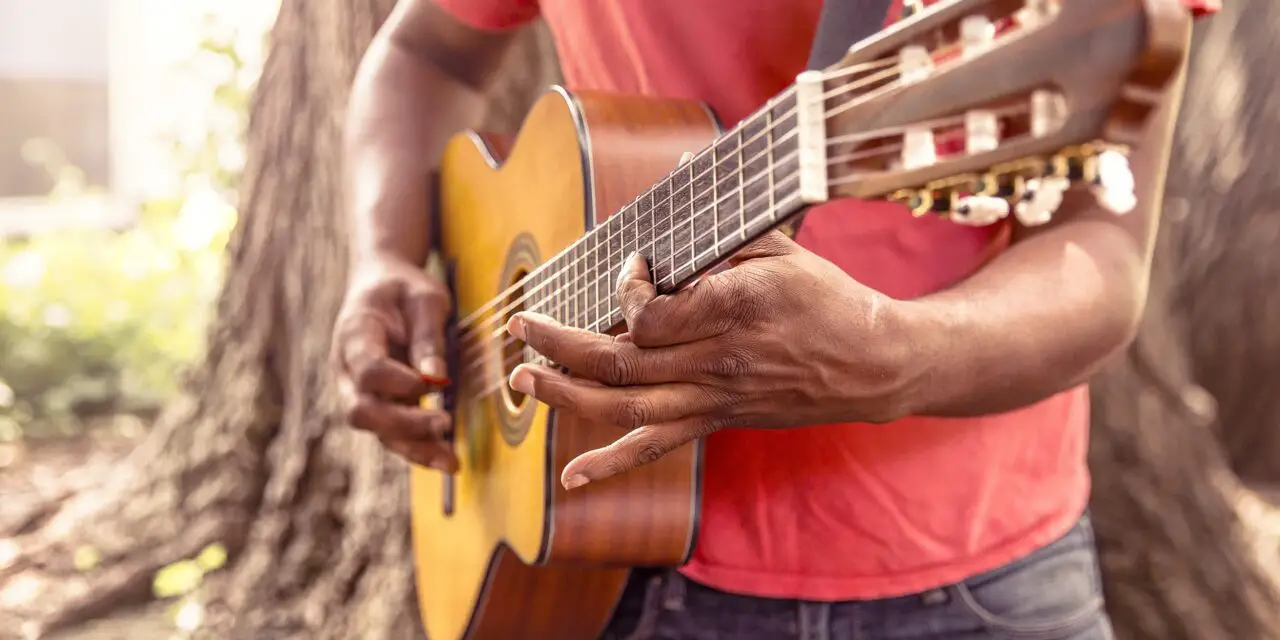So you’ve been wondering: how many chords do you need to know to write a song? Well, I have good news!
The topic of chords is huge, but the answer here is simple: by learning just four basic chords, you have everything you need to write great songs. In the major scale, those chords are the I, the IV, the V, and the vi.
Hang on, let me just translate those pesky Roman numeral scale degrees into the familiar key of C major real quick…
And voila! You have these chords: C major, F major, G major, and A minor.
Chords in Different Keys
Believe it or not, you could stop there, with the key of C and those four chords. When I first started writing songs, that’s how I got going!
But eventually, you’re going to make a music theory teacher cry if you write 25 different songs in just one key with all the same chords. You don’t want to make a music theory teacher cry, do you?
To venture out beyond the key of C, here are those same four chords in other common keys. Notice the parallel structure – each chord is a whole step higher as you change keys in music.
| I | IV | V | vi | |
| Key of C | C | F | G | Am |
| Key of D | D | G | A | Bm |
| Key of E | E | A | B | Cm |
| Key of F | F | Bb | C | Dm |
| Key of G | G | C | D | Em |
| Key of A | A | D | E | F#m |
| Key of B | B | E | F# | G#m |
Understanding Chords
Before we look at how you can make a ton of different songs with these four chords, it might help to quickly review this basic question: What is a chord?
Chord (n): A group of three or more notes that sound together, as the basis for harmony.
Chords are derived from the notes of scales, and when you put multiple chords together in a row, they form a harmonic structure called a “chord progression” that supports the instrumental or vocal melodies of a song.
To write your own songs, you just need to put a few of the chords we looked at earlier into a progression. Then, you can put a beautiful melody on top of it, sit back, and wait for your Grammy. (Huh, that reminds me… my Grammy should have arrived by now! Two star rating for The Recording Academy.)
Improve your songwriting by mastering piano.
$49
ONLY
How to Write a Song With Four Chords
In their song, The Axis of Awesome identified about 50 pop songs that used this chord progression:
I-V-vi-IV
They simplify things quite a bit, stripping down the arrangement to just a piano and making them all in the same key – but it’s clear that you don’t need a crazy complex progression to make beautiful music!
In fact, simple can be better in music. It’s certainly a reasonable place to start off a song!
Mixing Up Your Four Chords
The limitation in the “Four Chords” example is that it had songs with the same four chords in the same order, with the same number of bars for each, and the same rhythmic pattern. This isn’t how you have to do it – there are a lot of ways you can mix it up!
Even if you start with the same four chords, you can change their order in the chord progression, extend some of them for a few bars, and mess around with unique rhythms that add sophistication to your song.
For example, rather than going C-G-Am-F, you could try some of these progressions instead:
C-Am-F-G
C-F-G-C
C-C-G-G
Am-G-F-C
Here’s an example of a four-bar section with some different chords:
C / / /
F / / /
C / / /
Am / G /
In this example, notice that we split the last bar so that each chord got just a few beats. It sounds really nice!
But you may be asking yourself, “How do we know which order to put the chords?” Eventually, you’ll learn about cadences, which explain why the V chord (G major in the key of C) is the strongest way to end your progression, pulling you right back to the I chord (C major).
But if you’re still new to songwriting, don’t worry so much about the importance of music theory – just try different combinations and see what sounds good to you!
Adding a Rhythm to Your Song
Ready to make your four chord song more interesting? Use an interesting rhythm!
Your song’s rhythm could be based on eighth notes or sixteenth notes. Let’s look at an example:
Instead of pulsing on every eighth note:
1 and 2 and 3 and 4 and…
We could try to leave out some notes and just play on the 1, the “and” of 2, and the 4.
1 (and 2) AND (3 and) 4 (and)
This is a great rhythm that really drives the song forward. Try using this pattern on piano or guitar with a few different chord progressions and see how it sounds!
Finishing Your Song
Once you’ve chosen your chords and a rhythm, you have the foundation you need to add some kind of melody, either for vocals or an instrument.
And basically, that’s all it takes to finish writing a song. Here’s a handy equation I just made up to prove it:
Chords + rhythmic pattern + melody = song
Wait! What if I Still Don’t Know Any Chords?
Feeling like I jumped too far ahead? Are you still new to chords and how to play them?
I know how that feels!
Back then, I had no musical training beyond middle school concert band, and I didn’t even know what a chord was, much less how to use one in a composition!
You can still learn a lot about music without that music theory background. But eventually, it will help a LOT if you take the plunge and start learning some simple theory!
Don’t worry, it doesn’t have to be hard. I suggest you start small with these first four chords in the key of C major: C, F, G, and Am.
There are countless YouTube videos and music courses that will teach you that much – and once you know just these four chords, a world of songwriting will open up to you.
How Many Chords Do You Need to Know Wrap-up
I hope this gives you an idea of how to write a song using a few simple chords!
If songwriting still seems hard to you, I’ll leave you with a little bit of friendly advice: the first songs you write are going to SUCK! Even if you’re already a fantastic musician and you know a lot of music theory, the first songs you write are still going to suck!
Like, even your mom will politely decline if you ask her to listen to your first song.
… Okay, maybe not THAT bad!
But you have to keep in mind that songwriting is a skill like anything else, and practice is a huge part of the process. You’ll get an internal sense of what sounds good over time.
Don’t put too much pressure on yourself to write something amazing right off the bat. You might get lucky, but the goal right now is just to learn. The best way to become great is to write a lot of bad songs, take note of the process, and keep learning.
Ready? Get started right now with four chords!
If you REALLY want to advance your skill as a musician and a songwriter fast, I suggest you explore Piano for All. This piano course starts you off slow with some basic chords and rhythms, but by Module 3: Chord Magic, you’ll be learning lots of new chords that totally open up your playing – plus a handy “All Chords” memory trick. Check it out!
Improve your songwriting by mastering piano.
$49
ONLY


![Why is Songwriting So Hard? [The 3 Top Reasons]](https://improvesongwriting.com/wp-content/uploads/2019/09/Why-is-songwriting-so-hard-440x264.jpg)






